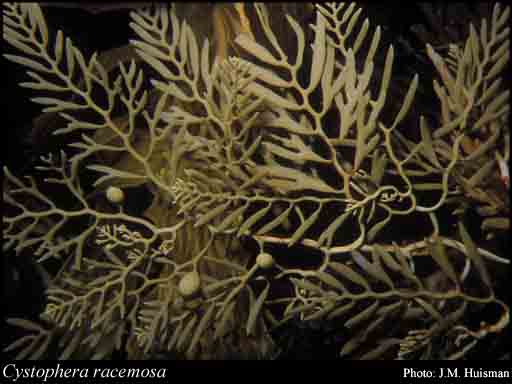- Reference
- Ofversigt af Forhandligar: Kongl. Svenska Vetenskaps-Akademien 441 (1870)
- Conservation Code
- Not threatened
- Naturalised Status
- Native to Western Australia
- Name Status
- Current

Scientific Description
Habit and structure. Thallus medium to dark brown, 40–100 cm long, with a robust primary axis, rigidly and openly complanately branched. Holdfast discoid-conical, 0.5–2(–3) cm across, with a single primary axis; epilithic. Primary axes compressed, 2–4(–6) mm broad and 1–2 mm thick, alternately distichously branched from the faces; secondary axes 10–30 cm long, 0.5–1 cm apart, retroflex; tertiary axes usually present; older secondary and tertiary axes and laterals readily lost leaving prominent scalariform residues 1–5 mm long. Laterals 2–6 cm long, 1–3 mm apart on axes, rigid, alternately pinnate with simple, compressed, lanceolate ramuli 0.5–1.5(–2) cm long and 1–2 mm broad, tapering to base and apex. Vesicles replacing basal 1(–2) ramuli of laterals, rarely absent, spherical to slightly ovoid, 3–8(–10) mm in diameter, mutic.
Reproduction. Thalli monoecious. Receptacles simple, lanceolate, compressed, 0.5–3 cm long and 1.5–3(–4) mm broad, margins smooth to slightly torulose. Conceptacles in two marginal rows with ostioles on the edges, bisexual or unisexual, with simple paraphyses; oogonia sessile, ovoid, 120–150 µm long and 80–120 µm in diameter; antheridia in apical clusters on branched paraphyses, ovoid, 25–35 µm long and 15–20 µm in diameter.
Distribution. From Geographe Bay, W. Aust., around southern Australia to Kangaroo I., S. Aust. Queenscliff, Vic.
Habitat. C. racemosa is a deep water species of western affinities.
[After Womersley, Mar. Benthic Fl. Southern Australia II: 378 (1987)]
Distribution
- IBRA Regions
- Esperance Plains, Jarrah Forest, Warren.
- IBRA Subregions
- Recherche, Southern Jarrah Forest, Warren.
- IMCRA Regions
- Leeuwin-Naturaliste, Pilbara (offshore), WA South Coast.
- Local Government Areas (LGAs)
- Albany, Augusta Margaret River, Busselton, Esperance, Manjimup.